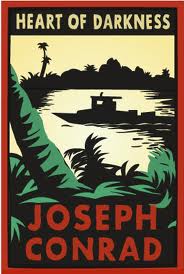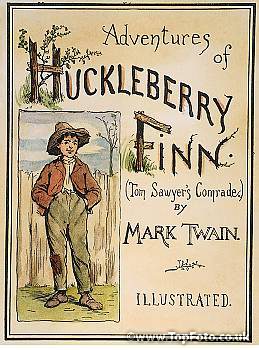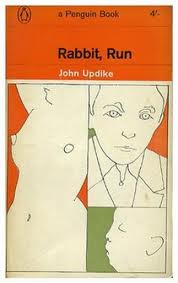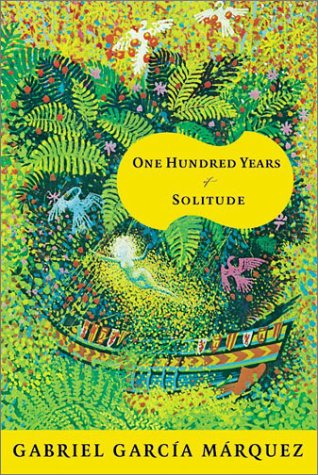Author Photo And Bio
 1. Heart of Darkness by Joseph Conrad (1899). In a novella with prose as lush and brooding as its jungle setting, Phillip Marlowe travels to the Belgian Congo to pilot a trading company’s steamship. There he witnesses the brutality of colonial exploitation, epitomized by Kurtz, an enigmatic white ivory trader. To understand evil, Marlowe seeks out Kurtz, whom he finds amongst the natives, dying. After Kurtz laments his own depravity through his final, anguished words—“The horror! The horror!”—Marlowe must decide what to tell his widow back home.
1. Heart of Darkness by Joseph Conrad (1899). In a novella with prose as lush and brooding as its jungle setting, Phillip Marlowe travels to the Belgian Congo to pilot a trading company’s steamship. There he witnesses the brutality of colonial exploitation, epitomized by Kurtz, an enigmatic white ivory trader. To understand evil, Marlowe seeks out Kurtz, whom he finds amongst the natives, dying. After Kurtz laments his own depravity through his final, anguished words—“The horror! The horror!”—Marlowe must decide what to tell his widow back home.
 2. Adventures of Huckleberry Finn by Mark Twain (1884). Hemingway proclaimed, “All modern American literature comes from . . . ‘Huckleberry Finn.’ ” But one can read it simply as a straightforward adventure story in which two comrades of conve nience, the parentally abused rascal Huck and fugitive slave Jim, escape the laws and conventions of society on a raft trip down the Mississippi. Alternatively, it’s a subversive satire in which Twain uses the only superficially naïve Huck to comment bitingly on the evils of racial bigotry, religious hypocrisy, and capitalist greed he observes in a host of other largely unsympathetic characters. Huck’s climactic decision to “light out for the Territory ahead of the rest” rather than submit to the starched standards of “civilization” reflects a uniquely American strain of individualism and nonconformity stretching from Daniel Boone to Easy Rider.
2. Adventures of Huckleberry Finn by Mark Twain (1884). Hemingway proclaimed, “All modern American literature comes from . . . ‘Huckleberry Finn.’ ” But one can read it simply as a straightforward adventure story in which two comrades of conve nience, the parentally abused rascal Huck and fugitive slave Jim, escape the laws and conventions of society on a raft trip down the Mississippi. Alternatively, it’s a subversive satire in which Twain uses the only superficially naïve Huck to comment bitingly on the evils of racial bigotry, religious hypocrisy, and capitalist greed he observes in a host of other largely unsympathetic characters. Huck’s climactic decision to “light out for the Territory ahead of the rest” rather than submit to the starched standards of “civilization” reflects a uniquely American strain of individualism and nonconformity stretching from Daniel Boone to Easy Rider.
 3. Nine Stories by J. D. Salinger (1953). Salinger gave his story collection the title Nine Stories, and that simple, enumerative title is just right, for the stories can be counted off like beads on a string: “For Esme with Love and Squalor,” “A Perfect Day for Bananafish,” and “Uncle Wiggly in Connecticut,” whose last line, “I was a good girl, wasnI?” never fails to break the reader’s heart. The pitch-perfect voices Salinger provides his characters make their dead-serious search for meaning taste like candy.
3. Nine Stories by J. D. Salinger (1953). Salinger gave his story collection the title Nine Stories, and that simple, enumerative title is just right, for the stories can be counted off like beads on a string: “For Esme with Love and Squalor,” “A Perfect Day for Bananafish,” and “Uncle Wiggly in Connecticut,” whose last line, “I was a good girl, wasnI?” never fails to break the reader’s heart. The pitch-perfect voices Salinger provides his characters make their dead-serious search for meaning taste like candy.
 4. So Long, See You Tomorrow by William Maxwell (1979). An old man recalls a story of murder and adultery in his childhood Illinois town, and how he came to betray the friend who witnessed them. This novel by the longtime fiction editor of The New Yorker is an American Remembrance of Things Past—heart breaking in its portrayal of a boy’s loss of innocence, and savvy about memory’s self-serving nature.
4. So Long, See You Tomorrow by William Maxwell (1979). An old man recalls a story of murder and adultery in his childhood Illinois town, and how he came to betray the friend who witnessed them. This novel by the longtime fiction editor of The New Yorker is an American Remembrance of Things Past—heart breaking in its portrayal of a boy’s loss of innocence, and savvy about memory’s self-serving nature.
 5. The Ponder Heart by Eudora Welty (1954). In this comic monologue filled with witty Southern colloquialisms and vivid images, Miss Edna Earle Ponder, who manages a hotel in a small Mississippi town, describes her family’s wonderfully peculiar history. Her story focuses on her uncle, the eccentric and irrepressible Daniel Ponder, whose poor marriages created as many problems as his generous heart.
5. The Ponder Heart by Eudora Welty (1954). In this comic monologue filled with witty Southern colloquialisms and vivid images, Miss Edna Earle Ponder, who manages a hotel in a small Mississippi town, describes her family’s wonderfully peculiar history. Her story focuses on her uncle, the eccentric and irrepressible Daniel Ponder, whose poor marriages created as many problems as his generous heart.
 6. Rabbit Angstrom — Rabbit, Run (1960), Rabbit Redux (1971), Rabbit Is Rich (1981), Rabbit at Rest (1990) — by John Updike. Read as four discrete stories or as a seamless quartet, the Rabbit novels are a tour de force chronicle, critique, and eloquent appreciation of the American white Protestant middle-class male and the swiftly shifting culture around him in the last four decades of the twentieth century. From his feckless youth as a promising high school athlete and unready husband and father in Rabbit, Run; through vulgar affluence, serial infidelity, and guilt as a car dealer in Rabbit Redux; to angry bewilderment over 1970s social upheaval in Rabbit Is Rich, the meaningfully named Rabbit Angstrom gamely tries to keep up with it all, to be a good guy. But the world is too much with, and for, Rabbit, who staggers through literal and metaphorical heart failure before finally falling in Rabbit at Rest.
6. Rabbit Angstrom — Rabbit, Run (1960), Rabbit Redux (1971), Rabbit Is Rich (1981), Rabbit at Rest (1990) — by John Updike. Read as four discrete stories or as a seamless quartet, the Rabbit novels are a tour de force chronicle, critique, and eloquent appreciation of the American white Protestant middle-class male and the swiftly shifting culture around him in the last four decades of the twentieth century. From his feckless youth as a promising high school athlete and unready husband and father in Rabbit, Run; through vulgar affluence, serial infidelity, and guilt as a car dealer in Rabbit Redux; to angry bewilderment over 1970s social upheaval in Rabbit Is Rich, the meaningfully named Rabbit Angstrom gamely tries to keep up with it all, to be a good guy. But the world is too much with, and for, Rabbit, who staggers through literal and metaphorical heart failure before finally falling in Rabbit at Rest.
 7. The stories of Andre Dubus (1936–99). The meditative leanness and working-class focus of Dubus’s stories often garners comparison to Raymond Carver, although Dubus is much more interested in religion (Catholicism) and place (the redneck towns northwest of Boston). His stories are shot through with brutal violence and alcohol, characters whoalternate between sanctity and transgression, and tough moral choices. In Dubus’s fiction, such as the novella We Don’t Live Here Anymore from his 1979 collection Separate Flights, lives change slowly; marriages crumble or move on, bruised and shaken; and his characters survive, to carry on after paying a price.
7. The stories of Andre Dubus (1936–99). The meditative leanness and working-class focus of Dubus’s stories often garners comparison to Raymond Carver, although Dubus is much more interested in religion (Catholicism) and place (the redneck towns northwest of Boston). His stories are shot through with brutal violence and alcohol, characters whoalternate between sanctity and transgression, and tough moral choices. In Dubus’s fiction, such as the novella We Don’t Live Here Anymore from his 1979 collection Separate Flights, lives change slowly; marriages crumble or move on, bruised and shaken; and his characters survive, to carry on after paying a price.
 8. The Sound and the Fury by William Faulkner (1929). A modernist classic of Old South decay, this novel circles the travails of the Compson family from four different narrative perspectives. All are haunted by the figure of Caddy, the only daughter, whom Faulkner described as “a beautiful and tragic little girl.” Surrounding the trials of the family itself are the usual Faulkner suspects: alcoholism, suicide, racism, religion, money, and violence both seen and unseen. In the experimental style of the book, Quentin Compson summarizes the confused honor and tragedy that Faulkner relentlessly evokes: “theres a curse on us its not our fault is it our fault.”
8. The Sound and the Fury by William Faulkner (1929). A modernist classic of Old South decay, this novel circles the travails of the Compson family from four different narrative perspectives. All are haunted by the figure of Caddy, the only daughter, whom Faulkner described as “a beautiful and tragic little girl.” Surrounding the trials of the family itself are the usual Faulkner suspects: alcoholism, suicide, racism, religion, money, and violence both seen and unseen. In the experimental style of the book, Quentin Compson summarizes the confused honor and tragedy that Faulkner relentlessly evokes: “theres a curse on us its not our fault is it our fault.”
 9. The stories of John Cheever (1912–82). Seemingly confined to recording the self-inflations and petty hypocrisies of suburban WASPs, Cheever’s short fiction actually redefined the story form, mixing minimalism and myth to create uniquely American tragicomedy. A master of the ambiguous ending, Cheever could also be direct: In “The Swimmer,” a man dreams of his family as he blithely “swims” home through his neighbors’ backyard pools, only to collapse at the door of his empty, locked house.
9. The stories of John Cheever (1912–82). Seemingly confined to recording the self-inflations and petty hypocrisies of suburban WASPs, Cheever’s short fiction actually redefined the story form, mixing minimalism and myth to create uniquely American tragicomedy. A master of the ambiguous ending, Cheever could also be direct: In “The Swimmer,” a man dreams of his family as he blithely “swims” home through his neighbors’ backyard pools, only to collapse at the door of his empty, locked house.
 10. One Hundred Years of Solitude by Gabriel García Márquez (1967). Widely considered the most popular work in Spanish since Don Quixote, this novel —part fantasy, part social history of Colombia — sparked fiction’s “Latin boom” and the popularization of magic realism. Over a century that seems to move backward and forward simultaneously, the forgotten and offhandedly magical village of Macondo — home to a Faulknerian plethora of incest, floods, massacres, civil wars, dreamers, prudes, and prostitutes — loses its Edenic innocence as it is increasingly exposed to civilization.
10. One Hundred Years of Solitude by Gabriel García Márquez (1967). Widely considered the most popular work in Spanish since Don Quixote, this novel —part fantasy, part social history of Colombia — sparked fiction’s “Latin boom” and the popularization of magic realism. Over a century that seems to move backward and forward simultaneously, the forgotten and offhandedly magical village of Macondo — home to a Faulknerian plethora of incest, floods, massacres, civil wars, dreamers, prudes, and prostitutes — loses its Edenic innocence as it is increasingly exposed to civilization.